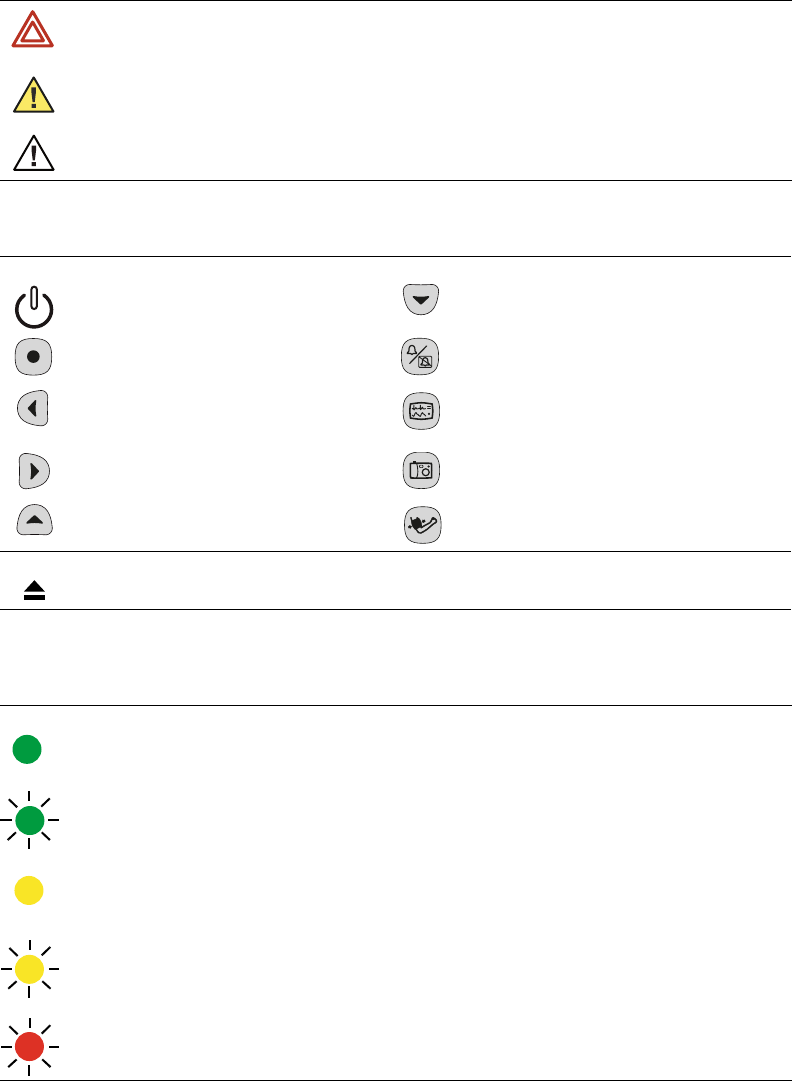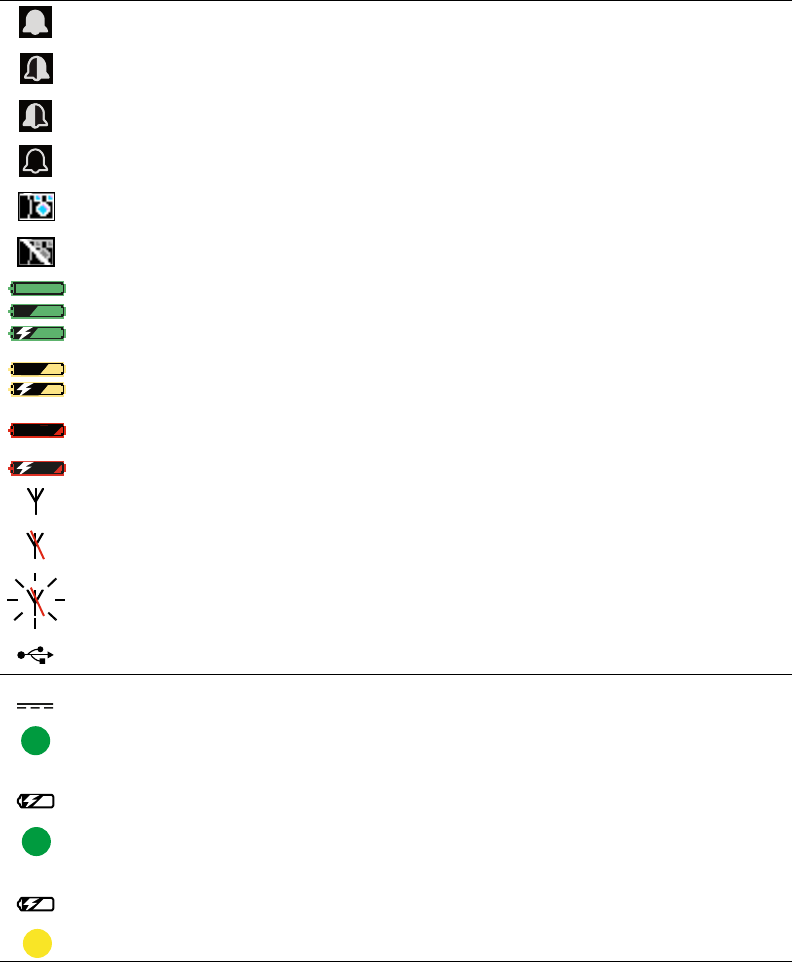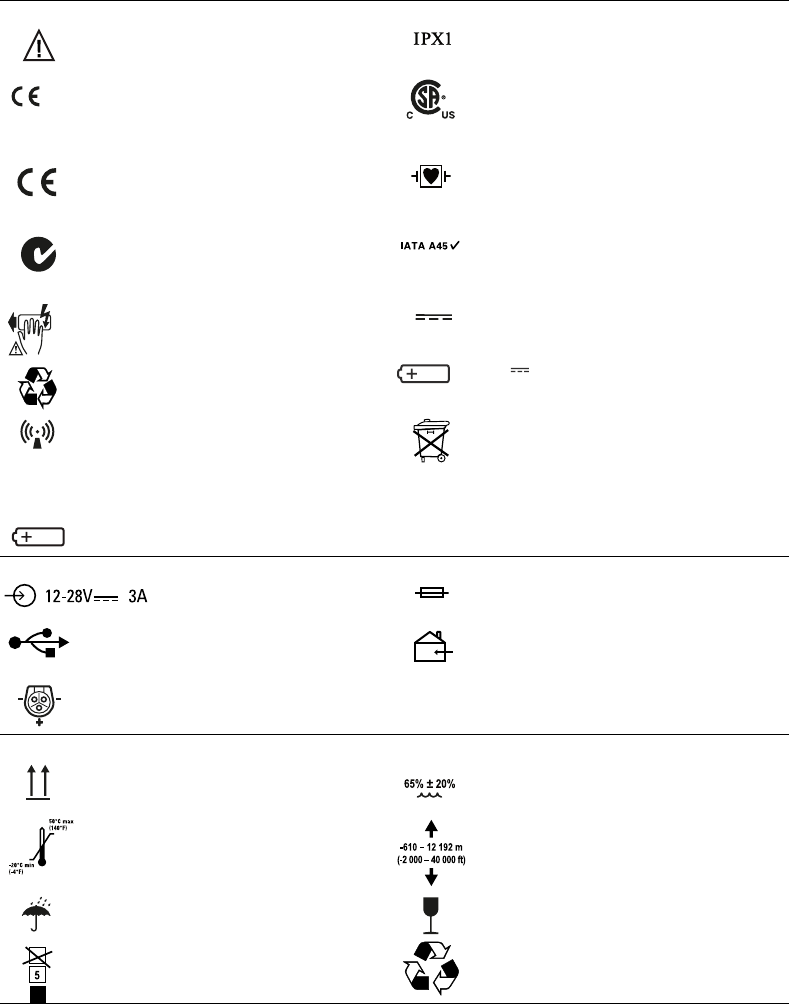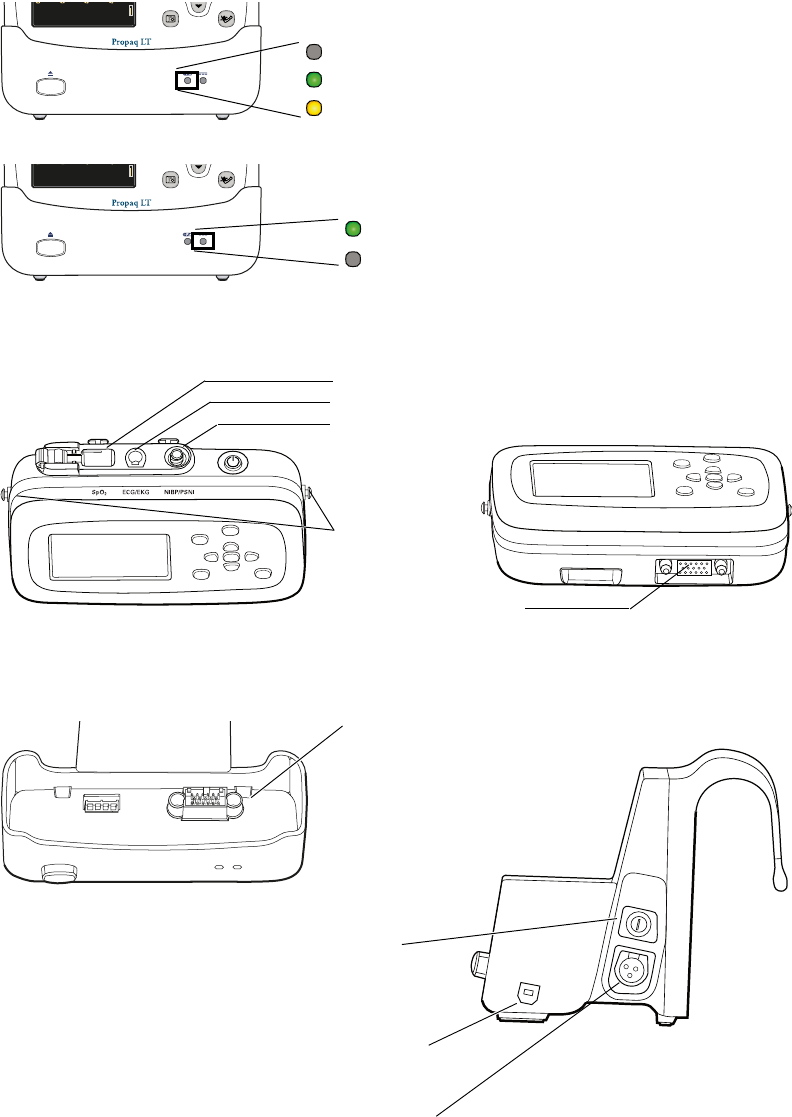Welch Allyn FN802FH Propaq 802 LTRN User Manual part 2 of 10
Welch Allyn, Inc. Propaq 802 LTRN Users Manual part 2 of 10
Contents
Users Manual part 2 of 10

1
1
Introduction
Intended Use . . . . . . . . . . . . . . . . . . . . . . . . . . . . . . . . . . . . . . . . . . . . . . . . . . . . .1
Symbols . . . . . . . . . . . . . . . . . . . . . . . . . . . . . . . . . . . . . . . . . . . . . . . . . . . . . . . . .2
Safety. . . . . . . . . . . . . . . . . . . . . . . . . . . . . . . . . . . . . . . . . . . . . . . . . . . . . . . . . . .5
Controls, Indicators, and Connectors . . . . . . . . . . . . . . . . . . . . . . . . . . . . . . . . . .8
Features and Functions . . . . . . . . . . . . . . . . . . . . . . . . . . . . . . . . . . . . . . . . . . . . 10
Models. . . . . . . . . . . . . . . . . . . . . . . . . . . . . . . . . . . . . . . . . . . . . . . . . . . . . . . . .10
Accessories . . . . . . . . . . . . . . . . . . . . . . . . . . . . . . . . . . . . . . . . . . . . . . . . . . . . . 11
USB Option . . . . . . . . . . . . . . . . . . . . . . . . . . . . . . . . . . . . . . . . . . . . . . . . . . . . . 11
HIPAA Considerations . . . . . . . . . . . . . . . . . . . . . . . . . . . . . . . . . . . . . . . . . . . . .12
Intended Use
The Propaq LT Series (802LT0N and 802LTRN) monitors are portable devices intended to
be used by clinicians and medically qualified personnel for single or multiparameter
vital-signs monitoring of ambulatory and nonambulatory neonate, pediatric and adult
patients. These devices are indicated for ECG, noninvasive blood pressure (NIBP),
respiration and SpO2. The most likely locations for patients to be monitored by these
devices are hospital general medical-surgical, telemetry, and intermediate care floors,
hospital emergency departments, transport, emergency medical services, and other
healthcare applications.
The monitors can be used as standalone devices or as devices networked to an Acuity
Central Station (referred to in this manual as ‘Acuity’) through wireless communication
over a Welch Allyn FlexNet network.
Federal USA law restricts this device to sale, distribution, or use by or on the order of a
licensed healthcare professional.
Even though this manual describes some monitoring techniques, the monitor is intended
for use only by trained and experienced clinicians who know how to measure and
interpret vital signs.

2Introduction Welch Allyn Propaq LT Vital Signs Monitor
Symbols
Table 1. Directions for Use
WARNING Indicates conditions that could lead to illness, injury, or death.
Caution In this manual, indicates conditions that could damage equipment or other property.
Caution On the product, means “Consult the accompanying documentation.”
Table 2. Control Buttons
Monitor
Power - Turn the monitor power on or off. Down - Move the cursor down to the next display
item.
Action - Act based on what is highlighted.
(See “Using the Action Button” on page 32.)
Silence/Reset - Silence the current alarm tone
for 90 seconds or reset a silenced alarm tone.
Left - Move the cursor left to the next display
item; decrease the parameter value.
Display - Cycle to the next configured display
format, or cancel the current control, setup, or
pop-up menu.
Right - Move the cursor right to the next
display item; increase the parameter value.
Snapshot - Record a 21-second period of numeric
and waveform data.
Up - Move the cursor up to the next display
item.
Start/Stop NIBP - Start or stop an NIBP
measurement.
Cradle
Monitor Release - Press and then hold while removing the monitor from the cradle.
Table 3. Status Indicators
Monitor
(green) Monitoring normally (no active alarms or alerts).
Connection to Acuity is confirmed and patient identification is confirmed. (Wireless only, Acuity enabled.)
(green flashing) Monitoring normally (no active alarms or alerts). (Standalone only.)
Patient confirmed, and monitor then intentionally disconnected. (Wireless only, Acuity enabled.)
(yellow) At least one alarm is disabled.
Monitor disconnected, connecting or connected; patient not confirmed. (Wireless only, Acuity enabled.)
(yellow flashing) Equipment alert.
Acuity message windows. (Wireless only, Acuity enabled.)
(red flashing) Patient alarm.

Directions for Use Introduction 3
Upper and lower alarm limits for this parameter are on.
The upper alarm limit for this parameter is on and the lower is off.
The upper alarm limit for this parameter is off and the lower is on.
Upper and lower alarm limits for this parameter are off.
A snapshot exists for this period.
The snapshot for this period has been replaced with a more recent snapshot.
(green) The battery is fully charged.
The battery is partially full.
The battery is partially full and is charging.
(yellow) The battery is low.
The battery is low and is charging.
(red) The battery is near failure; the monitor will shut down soon. If this indicator appears
while the monitor is in the cradle, the battery cannot be charged and must be replaced.
The battery is near failure and is charging. The monitor will shut down if removed from the cradle.
The monitor is communicating wirelessly with the network and with Acuity. (Wireless only, Acuity
enabled.)
The monitor is not communicating with the wireless network. (Wireless only, Acuity enabled.)
(Flashing) The monitor is communicating with the network but is not communicating with Acuity.
(Wireless only, Acuity enabled.)
The monitor is communicating by USB cable with a PC.
Cradle
(green) Cradle is powered.
(green) Monitor battery is charging.
NOTE: When the battery is fully charged, this indicator is not lit.
(yellow) Cradle fault or battery fault, or the monitor is not properly seated in the cradle.
Table 3. Status Indicators (continued)

4Introduction Welch Allyn Propaq LT Vital Signs Monitor
Table 4. Labels
Monitor
Proceed with caution. If in doubt, refer to the
accompanying documentation.
Enclosure protection: Drip-proof. Class IPX1
per EN60529:1991.
The monitor or accessory meets all essential
requirements of the European Medical Device
Directive
93/42/EEC for a Class II-b product.
The monitor is certified by the Canadian
Standards Association International to comply
with applicable US and Canadian medical
safety standards.
The monitor or accessory meets all essential
requirements of the European Medical Device
Directive 93/42/EEC for a Class I product.
Type CF patient connections, isolated for direct
cardiac application and protected against
defibrillation.
Australian registered importer. Hazard Class 9, IATA/ICAO (International Air
Transport Association/International Civil
Aviation Organization).
High voltage. Do not touch during
defibrillation.
Direct current.
Recycle the battery separately from other
disposables.
Battery replacement specification.
Electromagnetic interference might occur in
the vicinity of this monitor. (Wireless only,
Acuity enabled; see “EMC Compliance” on
page 179.)
Recycle the monitor, cradle, and battery
separately from other disposables. (See
“Recycling Monitor Components” on
page 162.)
Lithium-ion battery.
Cradle
Power in (DC). Fuse replacement specification.
USB cable connector. For indoor use only.
Input power (DC) pin pattern.
Product Packaging
Store this way up. Humidity limit.
Temperature limits. Altitude limits.
Rain protection required. Contents are fragile.
Stacking limit. Recycle the packaging material.
0123
N344
1900mAh
7. 4 V Li ++
Li ++
T3A/250V

Directions for Use Introduction 5
Safety
The monitor is safe for patients and clinicians when used in accordance with the
instructions and with the warning and caution statements presented in this manual.
All personnel must read and understand all warning and caution statements
presented in this manual before using the monitor.
• Failure to understand and observe any warning statement in this manual could
lead to patient injury, illness, or death.
• Failure to understand and observe any caution statement in this manual could
lead to equipment damage or loss of patient data.
General Warnings
These statements apply to all aspects of patient monitoring. Statements which apply
specifically to one aspect of monitoring, such as NIBP or SpO2 monitoring, are presented
in the corresponding sections of the manual.
WARNING Many environmental variables, including patient physiology and
clinical application, can affect the accuracy and performance of the monitor. The
clinician must verify all vital-signs information prior to patient intervention.
WARNING Always check the patient mode (adult, pediatric, or neonate) when
monitoring a new patient. The patient mode determines default alarm limits and
internal algorithm settings. Make sure the monitor has settings that are
appropriate before monitoring the patient.
WARNING Make sure Acuity patients, and especially those prone to
arrhythmias, are kept under close surveillance. While monitoring patients with
Acuity, the clinician must review all clinical data before implementing therapy. As
with all computerized arrhythmia analysis systems, Acuity cannot replace skilled
care and proper surveillance by a clinician.
WARNING It is possible for Acuity alarms, alerts, or other events to go
unnoticed if clinical personnel are not present at Acuity or if interruptions occur in
power or system operations. To help reduce this possible occurrence, Acuity
must be installed with redundant power supplies and redundant means of
operator surveillance, such as secondary Acuity Central Stations and hallway
message panels.
WARNING The monitor might not meet its performance specifications if stored
or used outside the specified temperature and humidity ranges.
WARNING Use of respiration monitoring by impedance pneumography can
affect the operation of some pacemakers. If pacemaker operation is affected, turn
off respiration pneumography. (See Figure 61 on page 61.)
WARNING Do not connect more than one patient to a monitor.
WARNING Do not connect more than one monitor to a patient.

6Introduction Welch Allyn Propaq LT Vital Signs Monitor
WARNING During defibrillation, keep discharge paddles away from the monitor
ECG lead wires, electrodes, any other monitor sensors, and other conductive
parts in contact with the patient.
WARNING Do not operate this product in the presence of flammable
anaesthetics or other flammable substances in combination with air or
oxygen-enriched environments. Failure to observe this warning can result in an
explosion.
WARNING Do not use the monitor in a Magnetic Resonance Imaging (MRI)
suite or a hyperbaric chamber. Such use can cause fire or explosion resulting in
patient injury and monitor damage.
WARNING Do not operate this monitor near equipment that emits strong
electromagnetic or radio-frequency signals. Electronic equipment of this type can
cause electrical interference with monitor operation, which can distort the ECG
signal and prevent accurate rhythm analysis.
WARNING To comply with Federal Communications Commission (FCC) RF
exposure requirements and to avoid exposure to radio-frequency (RF) radiation,
always use the monitor in accordance with the operating conditions and
instructions provided in this manual.
WARNING Pacemaker signals can differ from one pacemaker to the next. The
Association for Advancement of Medical Instrumentation (AAMI) cautions that “in
some devices, rate meters may continue to count the pacemaker rate during
occurrences of cardiac arrest or some arrhythmias. Do not rely entirely upon rate
meter alarms. All pacemaker patients should be kept under close or constant
observation.” See “Pacer pulse rejection” on page 165 for disclosure of the
pacemaker pulse rejection capability of this instrument.
WARNING Use only accessories supplied by Welch Allyn or recommended in
the Welch Allyn Products and Accessories guide (810-0409-XX). Use of any other
accessories can result in inaccurate patient data and damage to the equipment.
Always use accessories according to facility standards and the manufacturer’s
recommendations. Always refer to the manufacturer’s instructions.
WARNING Use only ECG cables supplied or specified by Welch Allyn. Use of
any other ECG cables can negate defibrillator protection and can create a risk of
patient injury due to shock.

Directions for Use Introduction 7
General Cautions
WARNING Frequently inspect—electrically and visually—all cables, sensors, and
electrode wires. Replace any damaged cables, sensors or wires. Failure to
properly inspect and keep in excellent working order all cables, sensors, and
electrode wires can result in hazards to patients and to equipment failure and
damage.
WARNING Always properly connect the electrosurgery return circuit. Improper
circuit connection can cause current to return through monitor electrodes and
probes, creating a burn hazard for patients.
WARNING Always keep patient motion to a minimum. Motion artifact can cause
inaccurate measurement of patient vital signs.
WARNING Carefully route and secure patient cabling, using the supplied
garment clips. Improperly routed and secured cabling can cause the patient to
become entangled in the cables, creating a strangulation hazard.
WARNING When the patient is wearing the monitor or being transported by
stretcher with the monitor connected, always take care to position the monitor
carrying straps on the patient. Be certain that the straps do not and cannot cross
the neck or throat and cause choking, and the straps do not restrict movement of
the patient’s arms or legs.
WARNING Never use a monitor that is not working properly. If the monitor is not
working properly, patient waveforms might be inaccurate or might not be
displayed.
WARNING If the monitor is damaged, or if you see any indication that the
monitor is not operating properly, disconnect it from the patient. Do not return it
to service until it has been inspected and, if necessary, repaired by qualified
service personnel.
Caution Do not autoclave the monitor.
Caution Autoclave accessories only if the manufacturer's instructions clearly
direct you to do so. Many accessories can be damaged by autoclaving.

8Introduction Welch Allyn Propaq LT Vital Signs Monitor
Controls, Indicators, and Connectors
Figure 1. Controls
Figure 2. Indicators: Monitor
1
40
40/
78
78
80
80
12
12
97
97%
HALL, ROBERT E.
HAL L, ROB ERT E.
3456187
3456187
3:00:06P
3:00:06P
Adult,
Adult,
Rm 239
Rm 23 9
HR/min
HR/min
NIBP mmHg (102)
NIBP mmHg (102)
@2:47P Manual
@2:47P Manual
Resp/min
Resp/min
SpO2
SpO2
SpO2
SpO2
2x
2x
II 1mV/cm
II 1mV/cm
Power Turn the monitor power on or off.
Silence/Reset Silence the current alarm tone for 90 seconds or reset a
silenced alarm tone.
NIBP Start/Stop Start or stop an NIBP measurement.
Snapshot Record 21 seconds of numeric and waveform data.
Arrows Move the display cursor up, down, right, or left to
highlight an item; change parameter values.
Action Act based on what is highlighted.
(See “Using the Action Button” on page 32.)
Display Cycle to the next configured display format, or cancel
the current control, setup, or pop-up menu.
Monitor release Release the monitor from the cradle.
1
40
40/
78
78
80
80
12
12
97
97%
HALL, ROBERT E.
HALL, R OBERT E.
3456187
3456187
3:00:06P
3:00:06P
Adult,
Adult,
Rm 239
Rm 23 9
HR/min
HR/min
NIBP mmHg (102)
NIBP mmHg (102)
@2:47P Manual
@2:47P Manual
Resp/min
Resp/min
SpO2
SpO2
SpO2
SpO2
2x
2x
II 1mV/cm
II 1mV/cm
Propaq LT
Yellow At least one alarm limit is disabled. (Standalone.)
Not monitoring (Wireless only, Acuity enabled).
Green Connection to Acuity is confirmed and patient
identification is confirmed.
(Wireless only, Acuity enabled.)
Green Monitoring normally; no active alarms or alerts.
(flashing) (Standalone.)
Patient was confirmed and the monitor was then
intentionally disconnected.
(Wireless only, Acuity enabled.)
Yellow Equipment alert. (Standalone.)
(flashing) Acuity message windows.
(Wireless only, Acuity enabled.)
Red Patient alarm.
(flashing)

Directions for Use Introduction 9
Figure 3. Indicators: Cradle
Figure 4. Connectors: Monitor
Figure 5. Connectors: Cradle
1
40
40/
78
78
80
80
12
12
97
97%
HALL, ROBERT E.
HALL, ROBE RT E.
3456187
3456187
3:00:06P
3:00:06P
Adult,
Adult,
Rm 239
Rm 23 9
HR/min
HR/min
NIBP mmHg (102)
NIBP mmHg (102)
@2:47P Manual
@2:47P Manual
Resp/min
Resp/min
SpO2
SpO2
SpO2
SpO2
2x
2x
II 1mV/cm
II 1mV/cm
Green Battery is charging
Off Cradle is not connected to power,
or cradle fault
Green Cradle is connected to power
1
40
40/
78
78
80
80
12
12
97
97%
HALL, ROBE RT E. 3456187 3:00:06P
Adult, R m 2 39
HR/min
HR/min
NIBP mmHg (102)
NIBP mmHg (102)
@2:47P Manual
@2:47P Manual
Resp/min
Resp/min
SpO2
SpO2
SpO2 2x
II 1mV/cm
Off Battery is full or monitor is not in the cradle
Yellow Battery or cradle fault, or monitor is not
properly seated in the cradle
SpO2 sensor connector
ECG/Resp cable connector
NIBP hose connector
Power and data connector
(from the cradle)
Strap connectors
USB connector for data to
and from the PC (optional)
Fuse holder
Power (DC) input connector
Monitor power and data connector

10 Introduction Welch Allyn Propaq LT Vital Signs Monitor
Features and Functions
• Monitoring of neonate, pediatric and adult patients
• Display of ECG, SpO2, and Resp waveform traces
• Accurate reading of NIBP in the presence of motion artifact, using Welch Allyn’s
patented Smartcuf motion-tolerant technology (available in 2006)
•SpO
2 monitoring with advanced technology for accuracy under conditions of low
perfusion and in the presence of motion artifact
• Configurable adjustments to alarm limits with ParamSet technology
• Standalone operation with local patient alarms and equipment alerts
• Optional two-way wireless communication within a Welch Allyn FlexNet network,
providing monitoring and remote control at an Acuity Central Station
• Color LCD for display of numerics and waveform data
• Configurable display formats and monitoring capabilities
• Internal antenna
• Rechargeable lithium-ion battery
• Weight of approximately 2 pounds (0.9 kg)
• Durability
• Tolerance of brief exposure to water
• HIPAA support
• Error detection
Models
The monitor is available in a standalone model (802LT0N) and a wireless model
(802LTRN).
Table 5. Model Descriptions
Feature Model
802LT0N
Model
802LTRN
3-lead and 5-lead ECG x x
Respiration rate (Resp) x x
SpO2xx
Noninvasive blood pressure (NIBP) x x
Radio for FlexNet wireless communication
with Acuity
x
Cradle to recharge the monitor battery x x
USB Option Option
Upload patient data from the monitor to a
PC and download custom monitor
configurations from a PC to the monitor
Option Option

Directions for Use Introduction 11
Accessories
The following accessories are available for use with the monitor and the cradle:
• Large Color Display Interface and cables
• IV pole mount
• Propaq LT Monitor PC Utility software (CD)
•Propaq LT Monitor Service Manual (CD)
•Propaq LT Monitor Directions for Use (CD)
• Patient carry strap
• Patient wearable strap
• Transport stretcher strap
• Connector panel plugs
•SpO
2 cables and sensors
• 3-lead and 5-lead ECG cables and cable extensions
• ECG electrodes
• NIBP hoses and cuffs
•Battery pack
• AC power adapter
For ordering information, see Welch Allyn Products and Accessories (810-0409-XX).
USB Option
The monitor can be purchased with the optional USB data transfer capability. This option
is required for the following:
• Downloading custom configuration files from a PC to the monitor.
• Uploading patient vital signs from the monitor to a PC (for printing).
WARNING Use only accessories supplied by Welch Allyn or recommended in
the Welch Allyn Products and Accessories guide.
WARNING Always use accessories according to your facility’s standards and the
manufacturer’s recommendations.
WARNING Always refer to the manufacturer’s directions for use.
12 Introduction Welch Allyn Propaq LT Vital Signs Monitor
HIPAA Considerations
Each medical facility is responsible for creating and enforcing policies and procedures to
guarantee compliance with the regulations defined in 45 CFR 160-164 of the Health
Insurance Portability and Accountability Act (HIPAA) of 1996.
The Propaq LT Monitor, the Large Color Display Interface, the Propaq LT Monitor
Configuration Utility, and the Propaq LT Monitor AutoPrint Utility incorporate security
features that support your implementation of the HIPAA requirements for ensuring that
patient information is kept private and confidential.
Monitor
• Clinicians can lock the monitor display to prevent the display of patient vital signs. For
patient protection when the monitor display is locked, the display is restored instantly
in the event of a button press (unless button-pad lock-out is enabled), an alarm or an
alert.
• Clinicians can lock the monitor buttons to prevent any unauthorized access to the
monitor controls. To protect the patient when the buttons are locked, access to the
buttons is restored instantly in the event of an alarm or an alert.
• All patient data transmitted by radio from the monitor is fully encrypted. This data can
be decrypted only by a Welch Allyn Acuity Central Station residing on the local Welch
Allyn FlexNet network. Transmitted patient data is sent via the 802.11
spread-spectrum, frequency-hopping protocol, using the Welch Allyn proprietary PSI
communications protocol.
Configuration Utility
The configuration utility never contains patient data.
AutoPrint Utility
• All patient data is stored in a Welch Allyn proprietary data format which is readable
only by machine.
• All patient data is deleted from the PC when it is sent to the printer.